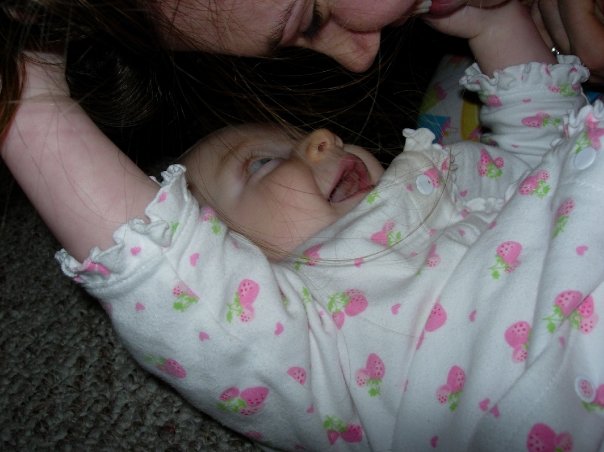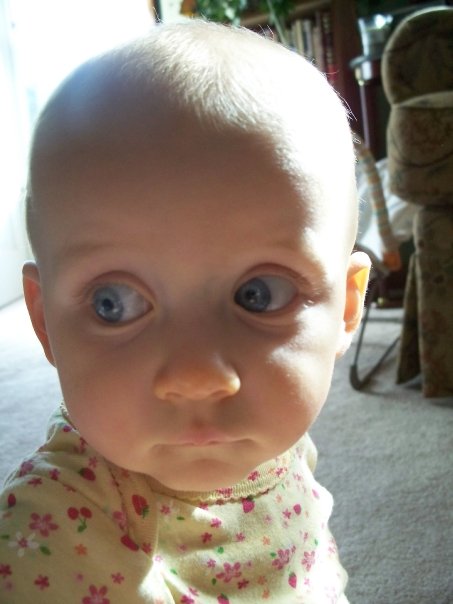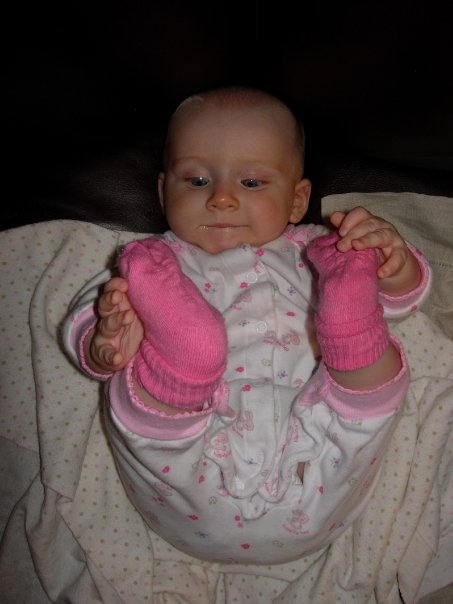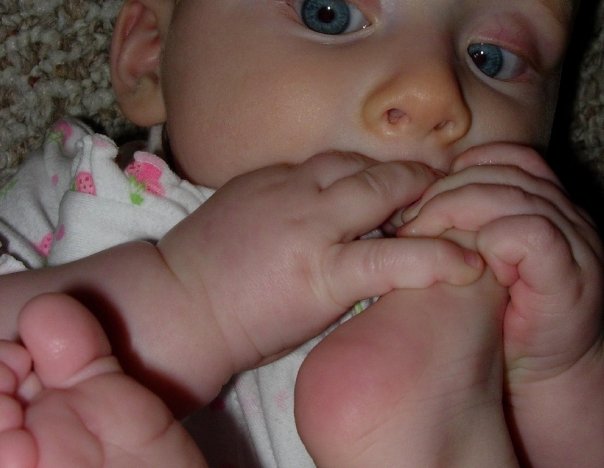Hope came to us in the form of a woman named Debbie.
Debbie was our “parent advisor,” sent to us by an agency in Georgia that works with families of children with special needs. I called the agency, they sent Debbie out in a matter of days.
I cleaned my house for approximately 3 days straight before our first appointment. I was a sleepless, anxious wreck, and I had no idea what to expect; what can you really do with a 4 month old infant?
Our appointment was at 10 am, and beginning at about 8:00, I prayed straight up until Debbie knocked on the door.
"Give me strength, strength, strength. Wisdom, wisdom, wisdom. Please let her be nice. Please let her be good at her job. Please let her be sensitive. Please let Madeline like her. Please let Madeline be in a good mood. Please let me like her. Please let her like me. Please let her be able to help us. Please let her know her stuff. Please don’t let me cry. Please don’t let her ask hard questions…"
It was "Please, please, please," right up until the knock on the front door. I opened it and there was a middle-aged lady standing there with brown, leather rainbow flip-flops on her feet, and a Vera Bradley purse slung over her shoulder.
Thank you Jesus! Did they send her here from North Raleigh, the motherland? Anyone with rainbow flip-flops is okay with me. I exhaled a little bit.
At this point, every doctor we’d seen told us, “Madeline cannot see. Her condition has no treatment. She will never see like we see. Get her all the therapy and education you can; because medically, there’s nothing anyone can do.”
Debbie was different. She told me right away, “I’ve done this for 20 years. I have several deaf-blind students that have gone on to receive their PhDs. And until Madeline is old enough to tell us that she can’t see anything, I’m going to assume that she can see something.”
I thought she was crazy. I was skeptical. I didn’t want false hope; I was not interested in a crutch.
That very first day, Debbie explained to me the anatomy of the human eye and brain (fascinating; insane; genius) and what exactly happens medically, anatomically, when someone has ONH. (I won’t go into it here, but if you’re interested, I've linked resources at the bottom of the page. )
The bottom line is that people with Madeline’s vision often have concentric or "tunnel" vision. When this is the case, people have little spaces, like holes, somewhere in their field where they can see. We call them "sweet spots." The best way I can explain it is this: it would be like someone holding a black sheet in front of you – then cutting a small hole in the sheet somewhere. You couldn’t see anything unless it was right behind that hole. Like the paper with a pinhole that you use to look at a solar eclipse. Or like looking through a drinking straw. So (if they're available vision is good enough), they can hold an object in their “sweet spot” and move the object/their head/their bodies until they’ve “seen” the whole thing.
They can’t drive, they still need canes or dogs, and it’s an incredible amount of work to look at something. Can you imagine trying to see an elephant, or a house this way? Moving your drinking straw up, down, and around – remembering everything you’ve seen and putting it all together like a puzzle in your head?
Debbie explained all this to me and said, “If Madeline has a sweet spot, we’ll have to help her find it. We’ll have to TEACH HER to see; it won’t come naturally. It will be work. But if we ASSUME that she can’t see anything, she’ll never learn to use whatever vision she has! We’ll make her more blind than she already is. So until she tells me she sees nothing, I’m going to assume she sees something.”
Okay, that makes a lot of sense. Maybe this lady knows what she’s talking about. Maybe Madeline can see something.
Hope.
So our job was to find out whether or not Madeline could perceive light. If her world was black, or shades of gray. Could she tell the difference between day and night? Could she see windows, find exits? Could she see shadows of large objects, like couches? Cars?
I had wondered what therapy you could possibly do with an infant that did nothing but sleep and breastfeed every two hours. What did I know! I had homework every single day of the week.
We were to sit in the darkest room in the house: our interior bathroom. No windows, no lights, door closed with a towel stuffed under the crack at the bottom. I was to bring a bright flashlight in there, hold Madeline in my lap, and turn the light off and on to see if I could get a response from her.
I would hold the light right in front of her and turn it on: no response.
So I’d turn it off and wait for her eyes to adjust back to the darkness (just in case). Next I’d move the flashlight to the bottom right: no response. Top right: no response. Peripheral. Bottom left... Over and over and over.
In the weeks that followed we spent hours in that dark bathroom with every kind of light source. Sometimes I would cry in there, all the time I would pray.
Then one day I brought Madeline’s bouncer in there. She laid in it, kicking her legs and making herself rock violently, giggling. I moved the flashlight around, turning it on and off. No response, just bouncing away without a care in the world.
Then I got to the bottom left. I turned on the flashlight – and she stopped. I froze. She didn’t turn her head to look, she didn’t reach. But she stopped what she was doing. She looked curious, confused. She SAW SOMETHING. I did another round with the flashlight and when I got back around to the bottom left side, and she stopped again! I snatched her up from the bouncer and kissed every square inch of skin on her.
In the days that followed, her responses were very inconsistent. We’d have great days where she’d reach out for the light , and then days where she didn’t care one lick about any light at all. But one thing WAS consistent - she never responded to light from any other direction, only the bottom left. We’d found our sweet spot.

- Madeline's eyes are almost always shifted to the right - because she sees out of the left side. When she's looking to the right, she's seeing what's directly in front of her (out of her "sweet spot" in her left peripheral). This photo was taken pre-diagnosis. She was already telling us where she could see, we just didn't understand her yet.
When I told Debbie, I expected her to celebrate with me. I expected hugs and praise, and “She can see!” Instead, she said, “Great, now what you have to do is…”
That’s it? A cursory ‘great’?
I love that about Debbie. She’s a woman on a mission and she never slows down. Just because Madeline has a success doesn’t mean we stop helping her. Debbie is always six steps ahead of me. That’s why she’s the best. She’s the reason Madeline learned to see. (Well, God via Debbie. You know what I mean.)
Learning to See: 101
From the get-go, Debbie had me reading pages and pages of information – how to communicate with a blind person, how to teach a blind person, how to touch a blind person, how to explain things to a blind person. How to organize my house, how to adapt books, how to adapt the pack n’ play. Debbie brought boxes of toys and tools. She taught Madeline how to sit up, and introduced her to 6,000 different textures. Things that NEVER would have occurred to me to do.
I thought vision loss was just – vision loss. The more I learned about the other things vision loss affects, the more I was astounded that ANYONE could get by without it.
Vision loss meant Madeline HATED being on her tummy. (Which as any mother knows is a pretty big deal.) She couldn’t see – so she had no motivation to pick up her head. She had no motivation to move. It just felt like her arms were trapped and the carpet was in her face. It was torture and she HATED it. Because she hated tummy-time she was behind developmentally. Her muscles weren’t getting the work they needed. She couldn’t sit up, she couldn’t crawl; she needed a physical therapist.
Vision loss meant no concept of day or night. It meant that she didn’t have visual “cues” for bedtime or mealtime. Every other infant saw mom going into the kitchen, grabbing a spoon, getting a bib and the food. Madeline didn’t. She couldn’t see the spoon in front of her face. She couldn’t see me getting a blanket, turning on the nightlight, walking to her room, or the darkness outside. I had to CREATE clues for her to indicate meal time, bedtime, bath time – to help her understand the concept of time and a schedule. To help her understand life. We had a “special blanket” that was only for sleeping. We never used it at any other time of day – so that when she FELT IT, she knew it was bedtime.
Vision loss meant that Madeline had to learn concepts that come naturally to other kids: up, down, in, out, in front of, behind, tall, short, long, wide, deep, beside, big, small: NONE of it has any meaning if you can’t see. How on earth do you describe a tree? It’s big, what does that mean? It’s brown. What does that mean? My whole world was different; it changed the way I looked at EVERYTHING.
We had to sew little jingle bells on her socks to help her find her feet, another developmental milestone. (It was really cute.)
Everything in the house had to be kept in its place. The diapers are always in the same place. This was an enormous challenge for me. I hate schedules. I don’t live by routines – never have.
We had to let her touch EVERYTHING. When I changed her, I went through this whole narrative,
“I’m picking up the diaper, can you hear it? It’s a little crinkly. Can you feel it? Oooh, it’s soft, and puffy. It feels like a diaper. Here is your cream – it comes from a tube. Can you feel the tube? Here, feel some cream. It’s cool. It’s smooth. Can you smell it? The wipe is cold. It’s wet – do you feel the wipe?”
It was…exhausting.
Although, if Madeline needed parents who could talk, God certainly gave her to the right pair. ;)
We had to teach Madeline cause and effect. Another concept that comes naturally if you have sight. We had to teach her object permanence: an object doesn’t cease to exist when she stops touching it. It doesn’t disappear into the darkness. Other children could see a TV sitting across the room – they knew it existed. Madeline didn’t. If it wasn’t touching her or making noise, it might as well have vaporized.
This made it REALLY difficult for me to get anything done. Madeline would launch into hysterics if I left the room, say, to pee. I would say,
“Mommy is going to the bathroom, I’m walking now, do you hear my voice getting further away? I’m still here. Mommy is in the bathroom. Mommy is peeing. Mommy is washing her hands. Do you hear the water? Mommy is coming back. Here I am. Mommy is still here.”
I talked ALL. DAY. LONG. I sat next to her ALL. DAY. LONG. If she dropped a toy, she couldn’t find it by herself – another skill that had to be taught. Talk about high-maintenance! It is the grace of God (and Dan) that I didn’t go insane.
We had our work cut out for us, to be sure. But we also had hope. We had direction, we had help, we had Debbie. And we had Christ, “our ever present help in times of trouble.”
To be continued…
The science, for all interested parties:
Madeline has "severe, bilateral ONH," meaning that her nerves are 5-10 percent of normal size, in both eyes. The smaller the nerve, the less functional vision. (The nerve passes information from eye to brain, like water through a hose. The smaller the hose, the less water.)
http://www.focusfamilies.org/focus/ONHbooklet/onhbooklet.pdf




